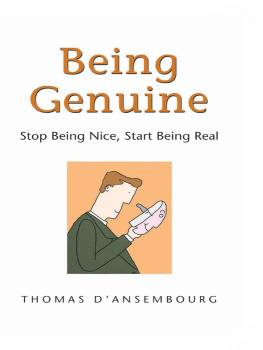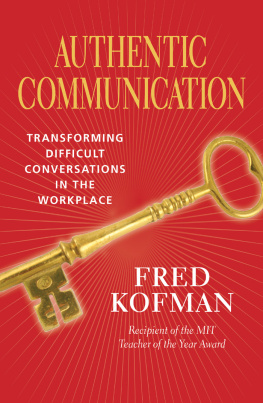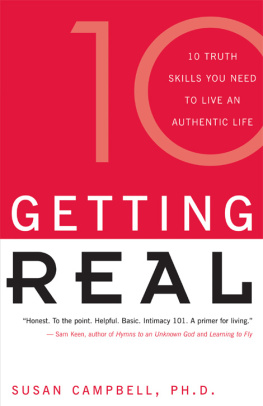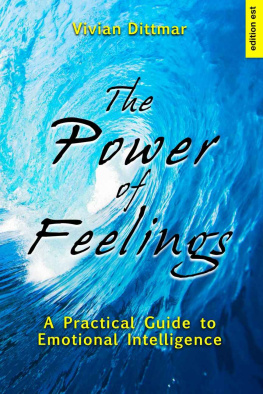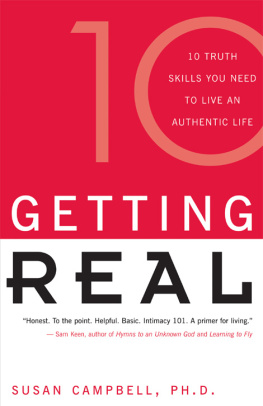Being Genuine
Stop Being Nice, Start Being Real
2007 PuddleDancer Press
A PuddleDancer Press Book
Originally published in French by Les Editions de LHomme
2001, Les Editions de LHomme
une division du groupe Sogides
All rights reserved. No part of this publication may be reproduced, distributed, or transmitted in any form or by any means, including photocopying, recording, or other mechanical or electronic methods, without the prior written permission of the publisher, except for use as brief quotations embodied in critical reviews and certain other noncommercial uses as permitted by copyright law. To request permission, contact the publisher at the following address, Attention: Permissions Coordinator.
PuddleDancer Press, Permissions Dept.
2240 Encinitas Blvd., Ste D-911, Encinitas, CA 92024
Tel: 1-858-759-6963 Fax: 1-858-759-6967
Ordering Information
Please contact Independent Publishers Group, Tel: 312-337-0747; Fax: 312-337-5985; Email: for other contact information and details about ordering online
Author: Thomas dAnsembourg
Translated by: Godfrey Spencer
Editor: Dan Shenk, CopyProof,
Index: Phyllis Linn, Indexpress
Manufactured in the United States of America
1st Printing, May 2007
2nd Printing, December 2008
3rd Printing, March 2010
10 9 8 7 6 5 4 3
ISBN: 978-1-892005-21-2
Publishers Cataloging-in-Publication
(Provided by Quality Books, Inc.)
DAnsembourg, Thomas.
Being genuine: stop being nice, start being real / Thomas dAnsembourg.
p. cm.
Includes bibliographical references and index.
ISBN 1-892005-21-2
ISBN 978-1-892005-21-2
1. Interpersonal communication. 2. Nonviolence.
I. Title.
BF637.C45D36 2007 158.2
QBI07-600002
I flit from perch to perch, in
an ever-shrinking cage, the door
of which is open, wide open.
G YULA I LLYS
Hungarian poet
The story of my life began on the day I decided not to
live it as if I was going up the down-escalator.
P ASCAL DE D UVE
Belgian poet
ACKNOWLEDGMENTS
M y gratitude goes first of all to Marshall Rosenberg with whom I trained in Nonviolent Communication (NVC). Meeting Marshall and learning what he taught brought me back to life at a time I was becoming a nice, dead person! Through his clarity, coherence, and integrity, this process of understanding oneself and others has contributed to changingthrough and throughboth my professional and emotional life.
My gratitude next goes to Anne Bourrit, a Nonviolent Communication trainer, in whose company I was lucky enough to decipher and clarify in myself the fundamental challenges that were making life so difficult for me. Valrie, my wife, and I keep Anne close to our hearts.
My deep gratitude also goes to Guy Corneau for his preface to this book and for his constant encouragements to write it. During many years of shared work and friendship, I have been touched and inspired by his great compassion for human beings and by his faith in life itself. He conveyed to me his desire to translate into simple language the psychological challenges that can seem so complex, as well as to contribute in this way toward enabling all, through a better understanding and a greater love of self, to become true co-creators of their lives.
My gratitude also goes to Pierre-Bernard Velge, the founder and living spirit of the nonprofit Flics et Voyouz (Cops and Hoods) organization. In the work we did with young people in difficulty over a period exceeding ten years, he awakened in me an ability to listen from the heart: listening without judging, listening to understand and love more.
And certainly my gratitude also goes to all those who placed their trust in me at workshops, private consultations, and conferences. It was out of the authenticity of our encounters and the beauty of the transformations undergone that my project of writing this book arose.
I further am infinitely grateful to Liliane Magi for patiently decoding my handwritten notes.
Finally, my gratitude goes to all of the NVC trainers in Switzerland, France, and Belgium with whom I have been privileged to work for their friendship and support.
To Valrie
and our children, Camille, Anna, and Jiulia,
with love, affection, and respect
CONTENTS
Preface
Moving From Being Nice to Being Genuine
Chapter 1
Why We Are Alienated From Ourselves
Chapter 2
Becoming Aware of What We Are Truly Experiencing
Chapter 3
Becoming Aware of What Others Are Truly Experiencing
Chapter 4
Creating a Space to Connect
Chapter 5
Emotional Security and Meaning: Two Keys to Peace
Chapter 6
Sharing Information and Our Values
Chapter 7
Method
Epilogue
Cultivating Peace
PREFACE
Moving From Being Nice to Being Genuine
E xpressing ones truth while respecting others and respecting oneself that is the journey on which attorney and author Thomas dAnsembourg invites us to accompany him. This is the invitation he extends to us in this book by suggesting that we plunge straight into the heart of how we enter into dialogue with ourselves and others. In it, we learn how to reprogram the way we express ourselves. Once that has been done, there comes the joy of being closer to others and closer to ourselves. There is the joy of being open to others. And at the heart of this process lies the possibility of giving up the familiar, even comfortable, confusions with which we so often content ourselves, instead of gaining access to a universe of choice and freedom.
What finer prospect, what finer program? This isnt about skimming the surface, like dragonflies flitting above a summer pond. Rather, the method of communication put forward by Thomas dAnsembourg calls into question our psychological makeup, inducing us to delve more deeply into ourselves and our relationships.
It is a demanding venture because in order to succeed in clearly formulating what is alive in ourselves, we often need to search out unconscious conditionings.
It is a revolutionary venture because along the road we discover that our plan to express our true self plainly puts our vulnerability on the line, puts our pride to the test.
It is a daunting venture because it highlights our propensity to leave things as they are for fear of upsetting othersand for fear that others might upset us in turn if we truly speak out.
Finally, it is a venture as challenging as it is stimulating, for it invites each of us to work on changing ourselves rather than expecting anyone and everyone else to change.
I personally became aware of the potential of Nonviolent Communication when I was traveling in the Sahara Desert. With the assistance of Jean-Marie Delacroix, I was guiding a group of twenty-four men who were taking part in a program called The Inner Flame. At Thomas dAnsembourgs suggestion, I had accepted responsibility for some young people from the Cops and Hoods organization, as well as some of its adult facilitators to provide us with technical assistance during this adventure. Some years earlier, I had learned that this organization was involved with street children. Pierre-Bernard Velge, the founder, and his right-hand man, Thomas dAnsembourg, had invited me to join them as psychological counselor for a desert expedition in which the troubled youngsters were taking part. I had subsequently persuaded the twenty-four men to join us in our program, and Id gotten really caught up in this venture, which was designed to help the men with their social reintegration.

